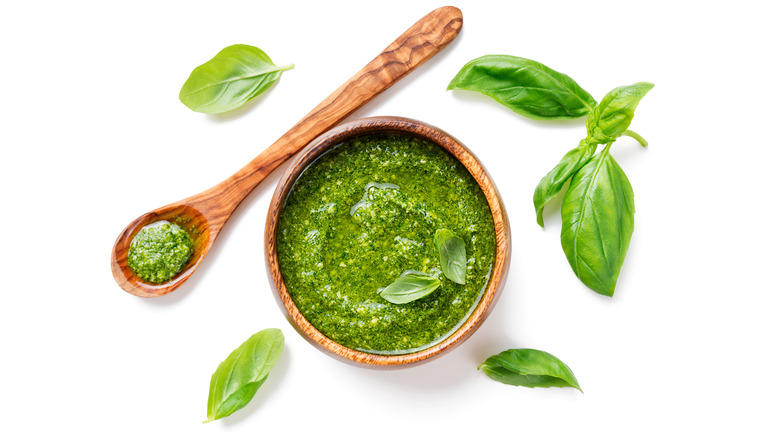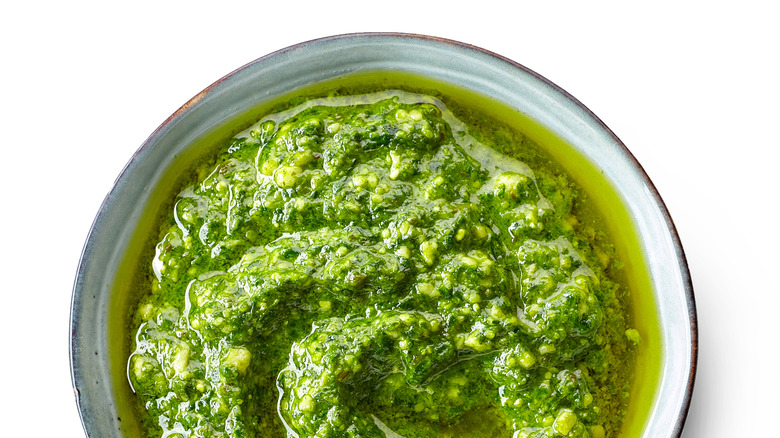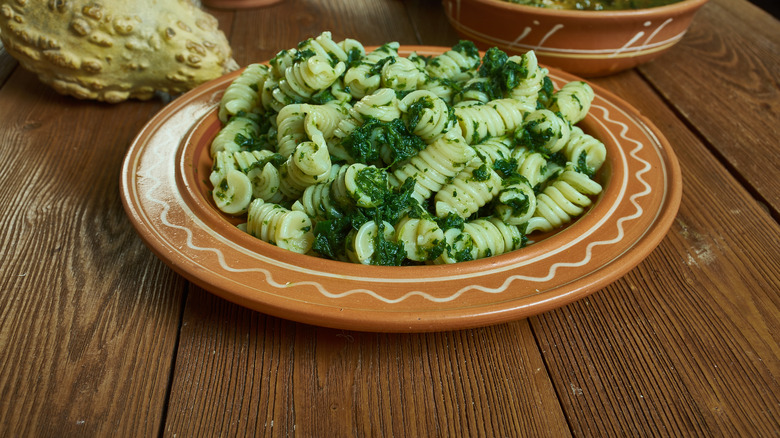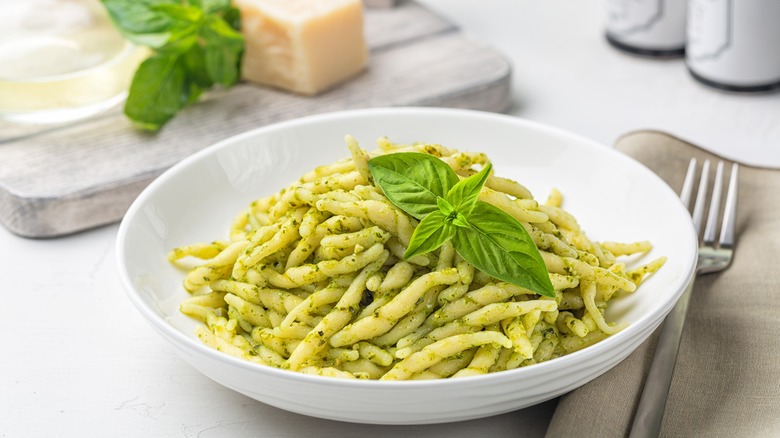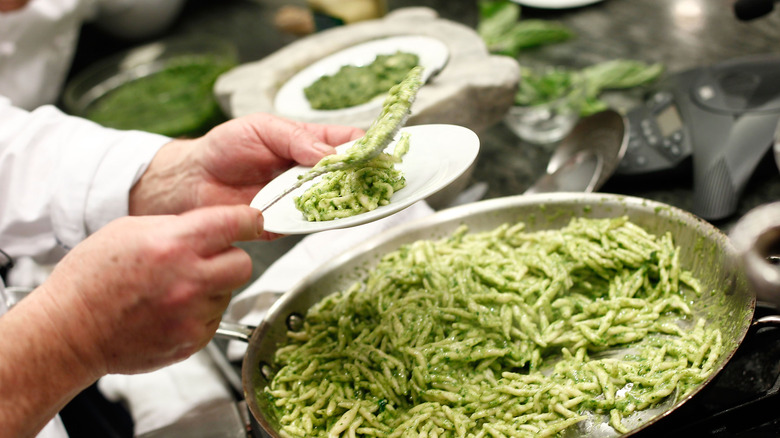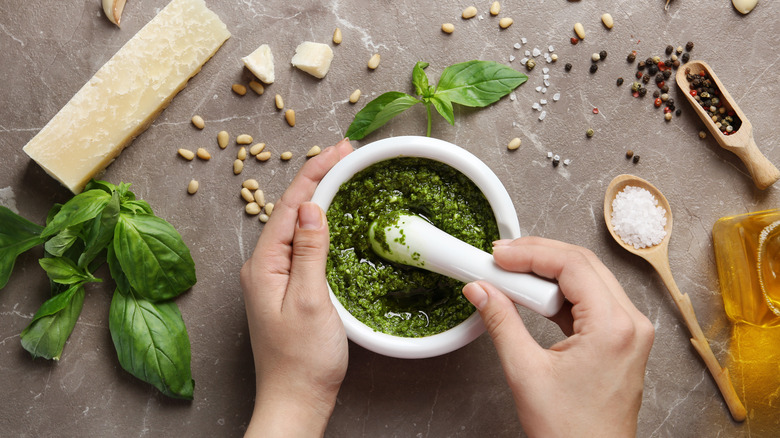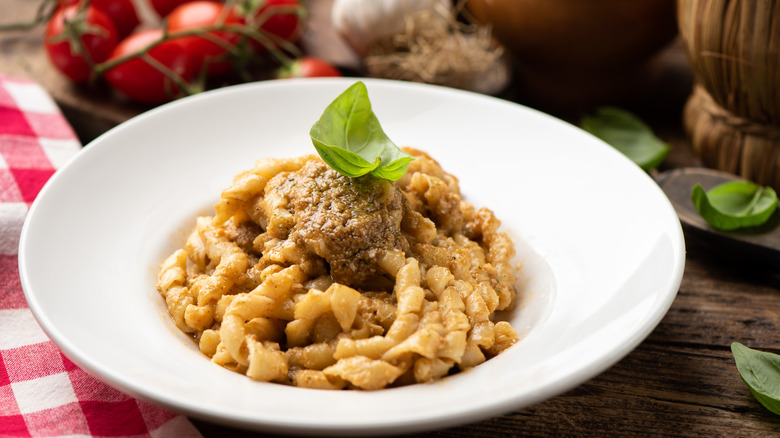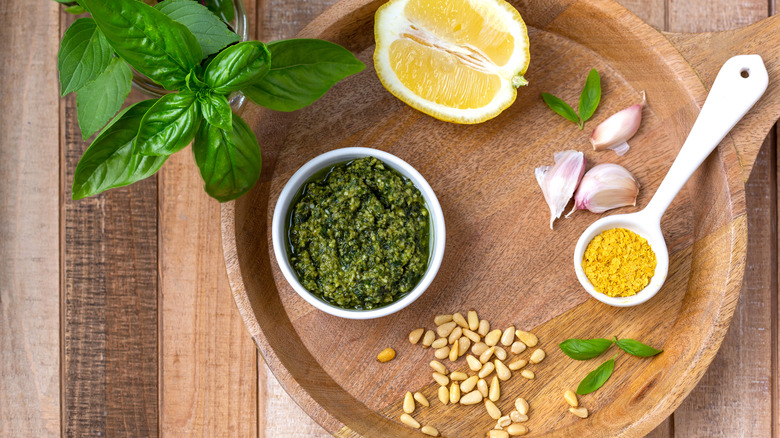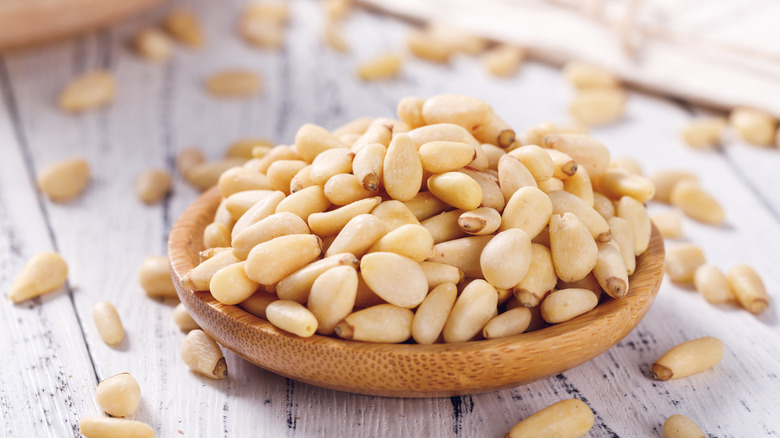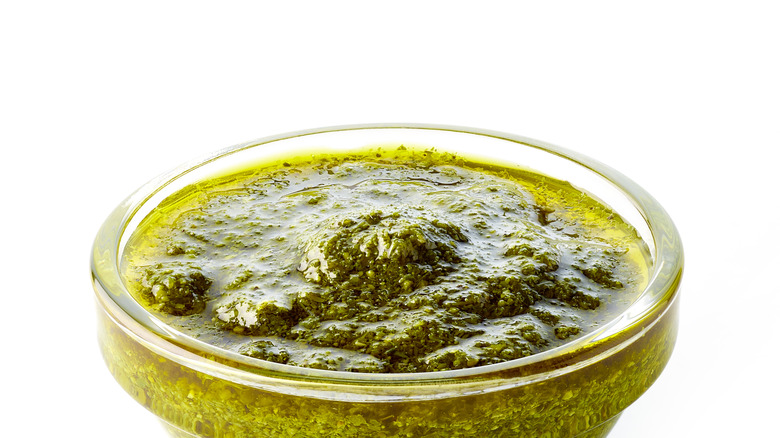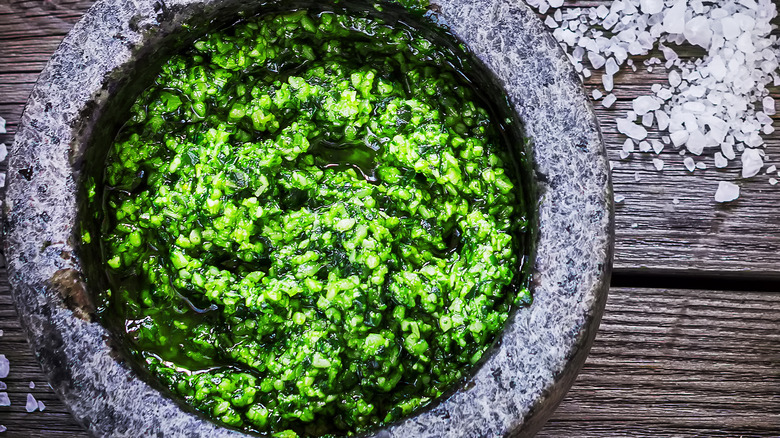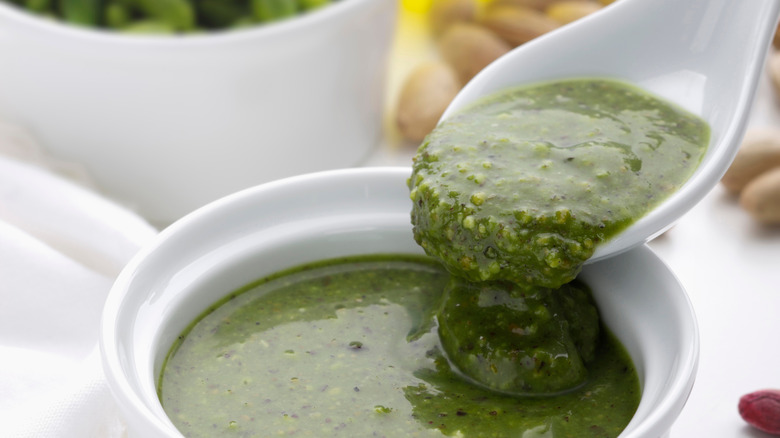The Untold Truth Of Pesto
If you're looking for a quick-and-easy dinner recipe, pesto pasta is one of the easiest options out there: Simply open a jar, mix it with cooked pasta, and dig in! According to La Cucina Italiana, this sauce is best consumed straight out of the jar without heating it up or messing with it too much. Additionally, pesto is highly versatile and can be used in sandwiches, lasagna, meatballs, as well as numerous pasta dishes.
Pesto is the second-most-popular pasta sauce. This stalwart favorite also has a rich history: The roots of pesto can be traced back to a condiment in Ancient Rome. Additionally, pesto is just one of many iterations of this Italian sauce.
These versions of pesto sauce range from traditional Ligurian creations to regional and contemporary renditions, from basil-based sauces to red pesto, and more. There's so much to know about this incredible sauce and the many ways in which it is consumed.
Pesto can be traced back to an Ancient Roman sauce
Pesto is Italian, but its roots actually predate modern Italy. The origins of pesto can be traced back to Ancient Rome. According to Ancient Roman food blog Pass the Garum, the sauce was immortalized in Virgil's poem "Moretum." In the poem, Virgil describes a mixture of celery, parsley, rue, cheese, coriander seeds, and an eye-watering amount of garlic. As per the poem, this mixture is then crushed in a mortar and pestle with olive oil and spread on fresh bread.
Of course, this sauce is missing several condiments we associate with pesto today, including basil. According to Eat & Walk Italy, Basil, which is native to the Arab world, didn't make its way to Italy until the Middle Ages. Moretum is certainly a close ancestor of pesto; however, since early recipes of moretum didn't contain basil, they would have resulted in a significantly different tasting sauce to the pesto we know and love today.
Pesto was invented in 19th century Liguria
Moretum dates back to Ancient Rome, and basil has been present in Italy since the Middle Ages: According to 5terre.com, the two didn't unite until 19th century Liguria. The website cites several popular legends linking the sauce to the area, including one that claims that monks at St. Basil monastery created pesto using herbs that grew in the surrounding hills.
Legends aside, according to La Cucina Italiana, the first known recipe for pesto was penned by Giovanni Battista Ratto, and it first appeared in the chef's 1863 book "Cuciniera Genovese." This recipe called for garlic, basil, Dutch cheese, and Parmesan to be pestled with butter and oil into a sauce that is highly similar to the types of pesto that are popular today.
Today, the region still lays claim to pesto, with Saveur noting that Liguria remains Italy's best-known region for the cultivation of basil. The village of Pra' is particularly well-known for its phenomenal crops of basil which grow in close proximity to the sea. The basil in Pra' is also often cultivated to DOP (denominazione d'origine protetta) standards, further elevating its overall quality.
In Liguria, pesto is often paired with trofie
According to Saveur, there are several variations within the varieties of pesto found in Liguria; however, there are a few governing principles that are generally always applied to the sauce. Ligurian pesto is traditionally made with pine nuts, garlic, salt, basil, olive oil, and cheese from Parma or Sardinia, and it's almost always eaten as a pasta sauce. In Liguria, pesto is paired with a specific kind of pasta called trofie that originated in the town of Recco. Pesto trofie is often mixed with green beans and potatoes.
Philos Kitchen notes that in Liguria, pesto can only be combined with specific types of pasta such as trofie and linguine. Pesto can also be eaten with corzetti, a round, thin sheet of pasta that is embossed using a stamp. During the Renaissance, families would traditionally stamp corzetti with their unique coat of arms.
A contest is used to determine the best pesto
Considering how passionate Italians are about pesto, it should come as no surprise that there is a contest to determine which pesto is better than the rest. According to Philos Kitchen, the very first International World Championship of Pesto took place in 2007. As per La Cucina Italiana, the championship has taken place once every two years since its origin. The contest brings together 100 competitors that pestle their pesto for a panel of judges.
The championship isn't just limited to professional chefs: Anyone can throw their hat in the ring, including amateur home cooks and pesto fans from beyond Italy. According to contest founder Roberto Panizza, the secret to success is to opt for DOP Genovese basil, which has the best flavor. Any other types of basil are unlikely to be up to snuff when it comes to crafting an award-worthy iteration of the classic local sauce.
Pesto is traditionally made using a mortar and pestle
While many of us may regularly use pesto from a store-bought jar, the sauce is best when made fresh with freshly-picked basil. And while some recipes do allow for the usage of blenders or food processors, the best and most traditional way to create pesto is to make it in a mortar and pestle. According to Serious Eats, using a mortar and pestle ensures a luxurious, richer, silkier sauce, and since the word pesto is close to the Italian word "pestare," which translates to "crush" or "mash," the pestling is essential to the process.
Additionally, according to La Cucina Italiana, the contest that crowns the best pesto in the world requires the use of a mortar and pestle. According to contest creator Roberto Panizza, while you can certainly make a tasty pesto in a blender, it will never be quite as good as one made using the traditional pestling technique.
There are several different iterations of pesto
While Ligurian pesto is probably the most famous rendition of the sauce, it's far from the only one out there: In the nearby town of Nice, for example, pistou is made with as few as three ingredients (basil, garlic, and olive oil). According to A Couple Cooks, pistou is a simpler version of the sauce that's fresh, light, and delicious. According to Serious Eats, Sicilian red pesto known as pesto alla trapanese is made with tomatoes, garlic, pecorino, and olive oil.
As per Gambero Rosso, this recipe arose when locals in Trapani adapted the traditional Genoese with ingredients that were more readily available to them. Pesto can also be made with herbs other than basil; according to EatingWell, pesto can incorporate lemon basil, dill, or cilantro, as well as greens like spinach, arugula, or watercress. Woodier herbs such as rosemary are best avoided since they are a bit too strong in flavor and tough in texture to suit this delicious sauce.
There are multiple ways of making vegan pesto
Traditional recipes for pesto rely on cheese: According to Saveur, pesto generally incorporates Parmigiano Reggiano or pecorino. According to Vegan Foundry, the most traditional versions of pesto are not suitable for a plant-based diet due to the presence of cheese. That being said, there are several brands that sell vegan versions of pesto.
These products either simply remove the cheese from the recipe, as with Amore pesto paste, which is the best-selling vegan pesto on the market. Some types of vegan pesto on the market, such as the Trader Joe's version, use cashews and kale, while others, such as Zest's vegan pesto, combine various nuts. According to Treehugger, some brands also replace the cheese in pesto with tofu or nutritional yeast. If you're making vegan pesto at home, you can use vegan Parmesan or miso paste to make a plant-based version of the sauce that your vegan friends will love.
Pine nuts can be substituted with different nuts
Pine nuts are the most classic base for pesto sauce and add a lovely flavor to the sauce. However, pine nuts can also be expensive; according to Today, these tiny nuts can be three and a half times as pricey as almonds. But, as it turns out, traditional pesto recipes do not incorporate pine nuts. According to Saveur, the earliest pesto recipes used walnuts rather than pine nuts. So, if you're balking at the price of pine nuts, you shouldn't feel bad about swapping these nuts with a more affordable alternative.
According to A Couple Cooks, pine nuts can be replaced with cashews, which mimic the soft texture and slightly sweet flavor of pine nuts. Almonds can also be used. Pistachios are another great option, and while pistachio-based pesto sauces will definitely have a distinct flavor, the green color of these nuts has the added bonus of making the pesto even more verdant.
Fresh pesto can oxidize without proper precautions
It's no surprise that fresh pesto is tastier than the stuff in a jar, but if you're going the homemade route, you'll want to consider serving the sauce as soon as it is made: According to The Kitchn, pesto tends to turn brown quite quickly due to oxidation, meaning that if you make your sauce too far in advance, it might be rather visually unappetizing in terms of color by the time it is served.
While oxidization can be avoided by blanching the leaves in boiling water for just a few seconds or adding a few drops of lemon juice, the best way to keep your pesto from turning brown is to cover it in a layer of olive oil, which will keep it from coming into contact with air (and thus prevent it from oxidizing). Another way to keep pesto green is to add some vitamin C powder.
Pesto can be used in a variety of dishes
While pesto is most frequently enjoyed as a pasta sauce, this is certainly not the only way to enjoy this flavorful sauce. There are several creative ways of using pesto, including stirring it into guacamole, adding it to a chicken salad, or using it in place of tomato sauce on a pizza. You can also try dolloping pesto on top of roasted sweet potatoes, stirring it into your favorite mac and cheese recipe, or spreading it on crostini or in sandwiches instead of mustard or mayonnaise.
It also pairs wonderfully with meat: Pesto can be used as a marinade for pork chops, or it can be slathered on chicken breasts before baking them on a sheet pan to form a delicious, aromatic crust that will really amplify the flavor of your chicken. There is no limit to the delicious ways that pesto can be used in the kitchen, so whip out your wildest ideas and get cooking!
Pesto might be saltier than you realize
In 2017, several brands landed in hot water for the amount of salt contained in their pesto. According to a survey by the Consensus Action on Salt and Health (CASH), some of the brands listed for having higher-than-recommended salt content included Sacla Italia Pesto No. 1 classic basil (one of the most popular pesto sauces in the UK) and Sacla Italia Pesto No. 2 sun-dried tomato, with 3.3 grams and 3 grams of salt per 100 grams of pesto respectively. Meanwhile, Napolina green pesto with basil was found to contain 2.5 grams per 100 grams, Gino D'Acampo Pesto alla Genovese basil pesto had 2.3 grams, and Truly Italian Genovese basil pesto counted 2 grams.
At the time of CASH's survey, 40% of pesto sauces on the UK market still exceeded the average salt content recommended. Some were even found to have more salt than previously reported in a similar survey conducted in 2009. Furthermore, pesto's versatility makes it not only a popular choice among adults, but for parents who include it in their children's diets too. The high salt content is particularly dangerous for children who should only consume 2 grams of salt per day between the ages of one and three, 3 grams between the ages of four and six, and 5 grams between the ages of seven and 10. This is especially important because it makes them vulnerable to developing strokes, hypertension, and heart disease as they age.
Celebrity chef Alex Guarnaschelli loves pesto
There's nothing quite like the moment when you taste something and it hits so many spots that you can't predict what exaggerated response your body is about to descend into. As it turns out, celebrity chefs aren't only left in tears because the dishes they're judging on award-winning cooking shows are so horrible. Sometimes, they're crying over pasta sauce.
According to The Recipe, celebrity judge and executive chef of Butter restaurant Alex Guarnaschelli, almost shed a tear over the pesto pasta served at her favorite restaurant La Merenda in Nice, France. While one would expect a celebrity chef's favorite dish to be found in an overly fancy spot, La Merenda is reportedly simple, unbothered about reservations, and furnished with stools and tables. A nice ambiance is good, but really, we keep going back to our favorite spots for the food.
As for her own pesto recipes, Guaraschelli reinvented the pesto wheel in 2021 when she made a basil, parsley, and arugula pesto for ZENB's pea-based pasta. For a gluten-free product that is said to do what most gluten-free pasta cannot –- that is, avoid turning into mush when boiled — it only made sense for the Japanese-inspired brand to be paired with the enthusiast's fresh produce pesto.
You can use pesto in desserts
Herbs are so often associated with savory flavors, except for mint which is commonly used in sweet dishes and drinks. For that reason, basil may not be at the top of your mind when it comes to desserts. Given its spicy-sweet aroma and taste, basil actually complements sweet flavors really well. For instance, you can make a watermelon granita using watermelon cubes, syrup, kosher salt, lemon juice, and water, topped with finely chopped basil leaves. Other fruits that also pair well with basil include strawberries, citrus fruits like lemon, lime, and orange, and stone fruits like mangoes, plums, and cherries.
You can even go all in and make a strawberry basil pesto. Larder Love food blogger Karon Grieve suggests using fresh strawberries, toasted almond flakes, basil leaves, black pepper, lemon juice, and honey. Give it all a blitz in your food processor and use it as topping for ice cream and cheesecake. So the next time you're making a fruit-based dessert and want to reach for mint to give it a fine finish, reach for basil instead and see what happens. And if you're feeling especially adventurous with your summer bakes, play around with basil in your toppings and see which one lands.
Pesto has tripped up MasterChef contestants
Sometimes what seems to be the simplest task ends in a colossal flop. Who hasn't had to scrape the char off a piece of toast? Add to that the high pressure and stakes of a reality cooking competition and the chances of tripping up skyrocket. This is exactly what happened to MasterChef Australia contestant, Courtney Roulston, in the second season of the franchise (via The Examiner). She dropped to the bottom and was eventually sent packing after a fit of pesto-induced panic when she added too much garlic to the sauce. She attributed the error to her preoccupation with making the sauce the right color and neglecting to taste it as she went along.
In Episode 4 of the 2021 installment of MasterChef: The Professionals, judge Monica Galetti presented a challenge in which the contestants had to prepare sun-dried tomato and burrata cheese stuffed agnolotti with a pea and mint pesto. Contestants Jamie Holme and Kirsty Rattray both left their pesto down to the last minute and ended up with a disaster. While Rattray's pasta skills were just as disastrous, Holmes showcased some skill but was eventually eliminated in the semi-finals.
